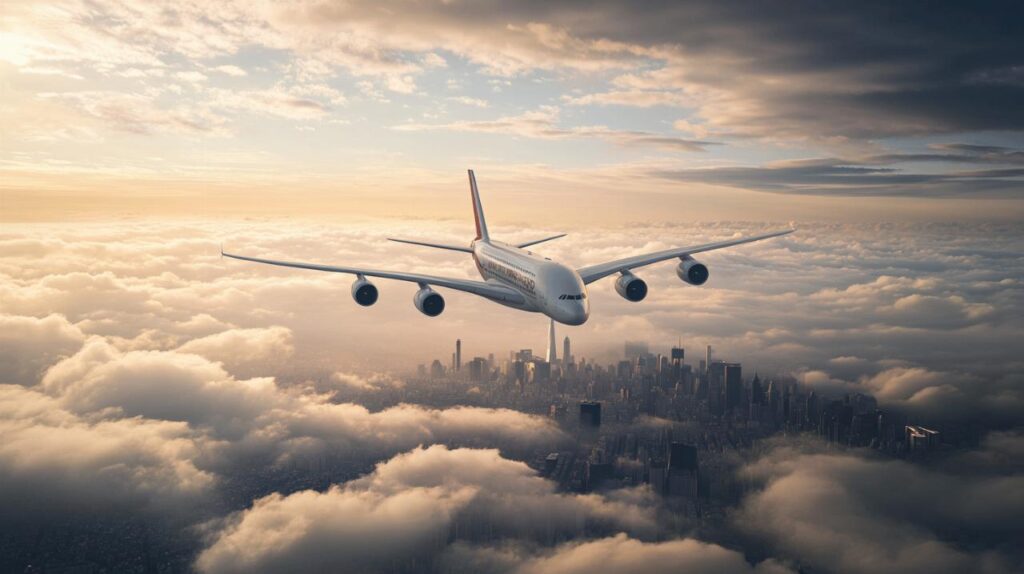Embarking on a transatlantic journey aboard the Airbus A380 from Paris to New York represents more than just a simple flight; it is an experience steeped in French aviation heritage and an opportunity to discover the distinctive elegance that defines French carriers. For British travellers seeking a blend of comfort, style, and efficiency, this route offers a fascinating glimpse into how French airline culture has shaped modern air travel, setting standards that resonate across the Atlantic.
Preparing for Your A380 Journey: Navigating Charles de Gaulle Airport
Essential Tips for a Smooth CDG Experience Before Your Transatlantic Flight
Charles de Gaulle Airport serves as the primary gateway for transatlantic flights originating from Paris, and understanding its layout can significantly enhance your travel experience. The airport's terminals are well signposted, but the sheer size of the complex can be overwhelming for first-time visitors. Arriving with ample time before departure is crucial, particularly during peak travel periods when security queues can extend considerably. British travellers accustomed to the bustle of Heathrow or Gatwick will find CDG equally busy, yet organised in a manner that reflects French efficiency. It is advisable to check in online whenever possible to streamline the process, as this allows you to proceed directly to security and avoid lengthy queues at check-in desks. The airport also offers various lounges, including the flagship facility which boasts around five hundred and forty seats, fine dining options, and even spa services, providing a tranquil prelude to your transatlantic voyage.
Understanding French Airport Procedures and What British Travellers Need to Know
Navigating French airport procedures requires a degree of familiarity with local customs and expectations. Unlike some British airports where the atmosphere can feel more relaxed, French airports often adhere to stricter protocols, particularly regarding security checks and boarding procedures. Passengers are expected to present their boarding passes and identification at multiple points, and any discrepancies can result in delays. British travellers should also be aware that French airport staff may not always speak fluent English, although most signage is bilingual. Patience and a polite demeanour go a long way in ensuring a smooth experience. Additionally, it is worth noting that Charles de Gaulle Airport has undergone numerous expansions and renovations, meaning that gate locations can change, and walking distances between terminals can be considerable. Allowing extra time for connections and familiarising yourself with the airport map before arrival can help mitigate potential stress.
The a380 experience: comfort and cabin classes compared
Economy Versus Business Class: Which Cabin Offers the Best Value for Money
The Airbus A380 operated by French carriers typically accommodates over five hundred passengers across multiple cabin classes, each offering distinct levels of comfort and service. Economy class seats are configured in a three-four-three layout, with a width of approximately seventeen and a half inches and a pitch of around thirty-two inches. While these dimensions are fairly standard for long-haul travel, some passengers have noted that the lower deck window seats can present discomfort due to the gap between the armrest and the fuselage wall. Despite this, the overall experience in economy class is enhanced by the spaciousness of the A380 and the inclusion of a decent in-flight entertainment system, which features a broad selection of films, music, and exterior cameras that allow passengers to view the flight path. Business class, on the other hand, offers a markedly elevated experience with pod-style suites equipped with sliding privacy doors. These suites provide ample space to work, dine, or rest, and are particularly valued by travellers seeking a productive and comfortable journey. The front rows of the business class cabin on certain aircraft types are often considered among the finest in the industry, offering extra legroom and an exclusive ambience.
Spaciousness and Seating Arrangements Aboard the Double-Decker Giant
The A380's double-decker design is one of its most distinctive features, and the upper deck is often regarded as the quieter and more exclusive section of the aircraft. Passengers seated on the upper deck benefit from a more intimate cabin environment, as the reduced number of seats contributes to a sense of tranquillity that is less pronounced on the lower deck. For those travelling in premium economy, the seating arrangement strikes a balance between the affordability of economy and the enhanced comfort of business class. With around thirty-eight seats in premium economy, passengers enjoy wider seats, increased legroom, and upgraded meal service, making it an attractive option for travellers who desire a touch of luxury without the premium price tag. The overall cabin ambience aboard the A380 is further enhanced by the aircraft's quieter engines and smoother ride, which contribute to a more relaxed and enjoyable journey. Whether you are seated in economy, premium economy, or business class, the A380 offers a level of comfort that is difficult to match on smaller aircraft types such as the Boeing 777 or Airbus A330.
Making the Most of Your New York Arrival: From JFK to Manhattan's Icons
Must-Visit Landmarks: Empire State Building and the Statue of Liberty
 Upon landing at JFK, the excitement of exploring New York City begins in earnest. The city is home to some of the world's most iconic landmarks, and no visit is complete without experiencing the grandeur of the Empire State Building and the historical significance of the Statue of Liberty. The Empire State Building, with its Art Deco architecture and observation decks offering panoramic views of the Manhattan skyline, remains a symbol of American ambition and ingenuity. Visitors can ascend to the eighty-sixth or one hundred and second floors for breathtaking vistas that stretch across the Hudson River and beyond. Meanwhile, the Statue of Liberty stands as a beacon of freedom and democracy, welcoming travellers from around the globe. A ferry ride from Battery Park takes you to Liberty Island, where you can explore the monument and learn about its rich history at the museum. Ellis Island, located nearby, offers further insight into the immigrant experience that shaped modern America. Both landmarks provide a profound connection to the past and a reminder of the values that continue to define the United States.
Upon landing at JFK, the excitement of exploring New York City begins in earnest. The city is home to some of the world's most iconic landmarks, and no visit is complete without experiencing the grandeur of the Empire State Building and the historical significance of the Statue of Liberty. The Empire State Building, with its Art Deco architecture and observation decks offering panoramic views of the Manhattan skyline, remains a symbol of American ambition and ingenuity. Visitors can ascend to the eighty-sixth or one hundred and second floors for breathtaking vistas that stretch across the Hudson River and beyond. Meanwhile, the Statue of Liberty stands as a beacon of freedom and democracy, welcoming travellers from around the globe. A ferry ride from Battery Park takes you to Liberty Island, where you can explore the monument and learn about its rich history at the museum. Ellis Island, located nearby, offers further insight into the immigrant experience that shaped modern America. Both landmarks provide a profound connection to the past and a reminder of the values that continue to define the United States.
Planning your return journey and future american adventures
As your time in New York draws to a close, planning your return journey becomes a priority. Many British travellers appreciate the convenience of direct flights back to London or other European cities, and booking in advance can often secure competitive pricing. For those with a thirst for further exploration, considering additional destinations such as Los Angeles or San Francisco can extend your American adventure. The West Coast offers a different flavour of the United States, with its laid-back culture, stunning coastlines, and vibrant tech hubs. Los Angeles, home to Hollywood and its myriad attractions, provides a sun-soaked contrast to the bustling streets of New York, while San Francisco's eclectic neighbourhoods and iconic Golden Gate Bridge offer a unique blend of history and innovation. When planning these journeys, it is worth comparing airlines and cabin classes to find the best fit for your budget and comfort preferences. Whether you opt for a French carrier, British Airways, or an American airline, each offers distinct advantages that can enhance your travel experience.
Airline comparisons: french carriers, british airways, and transatlantic options
Evaluating french aviation culture against british and american airlines
French aviation culture is characterised by a commitment to elegance, sophistication, and a distinct sense of national pride. Established in the early twentieth century, French carriers have cultivated a reputation for delivering an experience that reflects the nation's art de vivre, evident in everything from the menus curated by Michelin-starred chefs to the stylish uniforms worn by cabin crew. This attention to detail extends to the in-flight service, where passengers are treated to a level of hospitality that feels both personal and refined. In contrast, British Airways has long been associated with a more traditional, understated approach to service, emphasising reliability and a quintessentially British demeanour. American carriers, meanwhile, often prioritise efficiency and practicality, with a focus on maximising passenger capacity and streamlining operations. Each approach has its merits, and the choice between them often comes down to personal preference and the specific priorities of the traveller. For those who value culinary excellence and a culturally rich experience, French carriers stand out as a compelling option, while British Airways may appeal to those seeking familiarity and consistency.
Finding Direct Flights and Competitive Pricing for Your Next Voyage
Securing direct flights at competitive prices requires a combination of flexibility, planning, and a keen eye for deals. French carriers, as part of the SkyTeam alliance, offer access to an extensive network of destinations, serving over one thousand locations across more than one hundred and eighty countries. This alliance, which boasts an annual passenger count exceeding three hundred and forty million, provides travellers with a wealth of options for connecting flights and loyalty rewards. The Flying Blue loyalty programme, which attracts over one hundred thousand new members each month, allows passengers to accumulate miles that can be redeemed for future travel, upgrades, or other benefits. British travellers can also leverage partnerships with other airlines to maximise the value of their bookings, particularly when earning American Express points or Delta miles. Comparing prices across different carriers and booking platforms can reveal significant savings, and being open to alternative departure dates or times can further enhance affordability. For those who prioritise convenience and comfort, investing in premium economy or business class may prove worthwhile, particularly on long-haul routes where the additional space and enhanced service can make a substantial difference to the overall experience.



